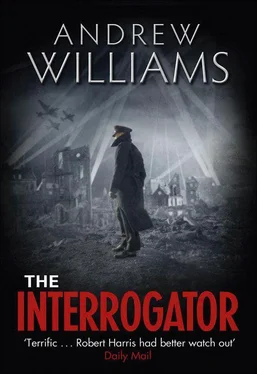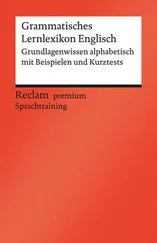‘I think we’d better go back. My wife will be waiting for me.’
They did not speak and the graveyard was silent but for the crunch of their shoes, figures in a monochrome landscape like something from a piece of forgotten archive film. Picking their way slowly between the stones, they found the main path and a few minutes later reached Lange’s grave. The cemetery workers were beating the hard ground between the pines flat with their spades, the rhythm like the ticking of a lazy clock. When it was level they loaded their tools into a handcart and left without a word, rattling down the gravel path to the gate. And Lindsay stood alone at the foot of the grave. He stood there until the raw earth was lost beneath the snow.
In the autumn of 1945 Commander Tighe of the Admiralty Signals Division submitted a secret report on German code-breaking efforts during the Second World War to the Director of Naval Intelligence. The report was considered ‘so disturbing and important’ that only three copies were made. In it, Tighe detailed the success of German cryptographers in repeatedly breaking both Royal and Merchant Navy codes and suggested that their efforts were responsible for many of the U-boat’s greatest successes in the Battle of the Atlantic. The Royal Navy’s codes were changed a number of times but the German B-Dienst was able to break into them again and again, often within a few weeks. The Admiralty was slow to recognise and interpret evidence that its codes were compromised and carry out the necessary investigation.
After the war, the success of the cryptographers at Bletchley Park in breaking the German Enigma ciphers helped to shield the Royal Navy from critical scrutiny over the failure of its own codes. In his report, Commander Tighe concluded that British code security was so disastrously lax that it cost the country dearly in men and ships and ‘very nearly lost us the war’.
Many of the characters are based on real people although most of the events described are fictional.
Admiral John Godfrey was the Director of Naval Intelligence until 1942 and Ian Fleming, the author of the James Bond books, was his assistant. Fleming was instrumental in recruiting people to the Division and those who worked with him often remarked on his love of cloak-and-dagger operations. The man charged with responsibility for tracking German U-boat operations from the Citadel was Rodger Winn and while none of the duty officers in Room 41 were women, a Margaret Stewart held this position across the corridor in Room 30 where the movements of the enemy’s surface fleet were plotted. Her confidential memoir of life in the Citadel is in the National Archive in London (ADM 223/286).
For further details of the Citadel and the work of the Combined Services Detailed Interrogation Centre (CSDIC) I quarried written sources but also the memories of those who visited and worked there. I am particularly grateful to the late Colin McFadyean who served as a naval interrogator and at the end of the war became head of the section. Transcripts of the secret recordings (SR reports) made of German prisoners at CSDIC, notes on the detailed interrogation of U-boat crews, and intelligence assessments written by the interrogators exist in the National Archive (Record groups ADM 223 and WO 208). They provide an invaluable insight into the work of Section 11 and the views of U-boat prisoners. Occasionally I have quoted from these documents, for instance, the observation made in 1941 by the then head of Section 11 that it was a mistake to use Jewish interrogators or men of ‘Jewish appearance’ (ADM 223/475). I have also drawn on authentic pieces of special intelligence, including some of the Enigma decrypts from Bletchley Park that suggested British codes might be compromised in the spring and summer of 1941 (ADM 223/2). Evidence that prisoners let slip valuable intelligence on the work of the B-Dienst can be found in CSDIC secret recordings made in March 1941 (WO 208/4141).
Although there were three U-boat commanders with the name Mohr, none of them served on Admiral Dönitz’s Staff or fell into British hands. One of Admiral Dönitz’s most senior Staff officers was the distinguished U-boat commander Günther Hessler, who sank fourteen ships off the coast of West Africa in May and June of 1941. The official history he wrote for the Ministry of Defence after the war was an important source for the German Staff perspective on the Battle of the Atlantic.
The most successful commander of the war, Otto Kretschmer of U-99 , was captured in March 1941, brought ashore in Liverpool and taken to Trent Park for interrogation. The officers of U-99 were then transferred to Grizedale POW camp in the Lake District. His first officer, Hans-Jochen von Knebel Doeberitz, had served for a time on the Staff as Dönitz’s adjutant. During Kretschmer’s time as the senior German prisoner at Grizedale, a secret Council of Honour was held to question and judge the First Officer of the ill-fated U-570 . In August 1941 the inexperienced commander and crew of the boat had panicked and surrendered to a British aircraft at sea. The first officer was found guilty of cowardice by the Court of Honour for his part in the affair and ostracised by the other prisoners, but he was not beaten. In an effort to regain his good name, he attempted to escape and was shot while on the run in the Lake District. There were two investigations into the Court of Honour but no charges were brought against Kretschmer or any of the other prisoners at the camp. After the war, Otto Kretschmer served as an Admiral in the West German Navy. A more disturbing example of a kangaroo court took place at a POW camp in Scotland in December 1944 when a prisoner called Wolfgang Rosterg was wrongly accused of giving information to the British. He was brutally beaten and hanged by some of the SS prisoners in the camp. Five men were eventually tried and executed for the crime, although many more had played a part.
Camp 020 was MI5’s secret centre at Ham Common, London, where spies were interrogated and broken by the formidable Colonel Stephens and his team of interrogators. There is no evidence to suggest that physical torture was used by the Security Service but a senior officer in one branch of Military Intelligence [MI 19] who spent time at the camp is known to have used excessive force. A number of secret reports were written by Naval Intelligence, MI5 and Military Intelligence personnel after the war describing their interrogation techniques in some detail and I have made use of these. The memories of the master Luftwaffe interrogator Hanns Joachim Scharff, quoted in The Interrogator by Raymond F. Tolliver (Schiffer 1997), were also useful, as were more contemporary British and American police sources. It was not unusual for POWs to be taken to bars and theatres in London in an effort to win their confidence and a special fund existed for this purpose.
The Royal Navy lost a number of escorts like the Culloden on convoy duty in the course of the war but particularly shocking was the sinking of HMS Firedrake . The destroyer, Firedrake , was cut in half by a torpedo while on convoy duty in the Atlantic in December 1942 and all but twenty six of her crew of 194 men were lost. A secret Admiralty report was critical of decisions made by her captain (ADM 199/165). No official Board of Inquiry was held into the loss of the ship. For the effects of Post-Traumatic Stress Disorder on war veterans, I spoke to both Merchant and Royal Navy seamen and was able to draw on a number of recent medical studies. Of particular valve were J. P. Wilson, B. Droždek, and S. Turkovic: ‘Post-traumatic shame and guilt’, Trauma, Violence and Abuse , vol. 7, no. 2, April 2006, 122–141, and R. E. Opp and A. Y. Samson, ‘Taxonomy of guilt for combat veterans’, Professional Psychology: Research and Practice , 20, 1989, 159–165.
Читать дальше












